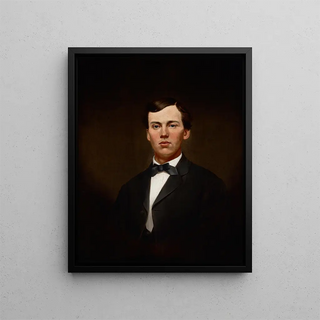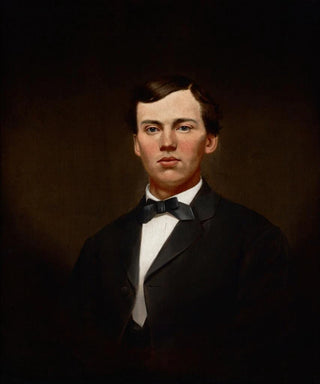Art print | Portrait of William Gurley Munson - William Merritt Chase


View from behind

Frame (optional)
Portrait of William Gurley Munson - William Merritt Chase – Captivating Introduction
In the vast panorama of American art history, the "Portrait of William Gurley Munson" by William Merritt Chase stands out for its ability to capture not only the physical appearance of its subject but also the very essence of his character. This painting, imbued with delicacy and psychological depth, offers a window into American society at the turn of the 20th century. Contemplating this work, the viewer is transported to a world where light and shadow dance across the canvas, revealing the subtleties of Munson's personality with remarkable finesse. Chase, through this portrait, does not merely depict a man; he evokes a universe, an era, and an artistic sensibility that continue to fascinate.
Style and uniqueness of the work
Chase's style is characterized by an impressive mastery of color and light, inherited from European Impressionists. In the "Portrait of William Gurley Munson," this technique manifests through bold brushstrokes and a vibrant palette that give the painting an atmosphere that is both intimate and dynamic. The delicate nuances of Munson's skin, as well as the play of light reflected on his clothing, testify to a meticulous attention to detail that transcends simple representation. Chase manages to establish a dialogue between the subject and the environment, creating a visual harmony that invites the viewer to immerse themselves in the work. Every element, from the background to Munson's posture, is carefully orchestrated to tell a story— that of a man both rooted in his time and timeless.
The artist and his influence
William Merritt Chase, an emblematic figure of American Impressionism, established himself as a pioneer in the field of portraiture. His innovative approach, which combines realism and impressionism, paved the way for many artists who followed him. Chase was not only a talented painter; he was also a passionate teacher, sharing his artistic vision with students at the Pennsylvania Academy of the Fine Arts and the New York School of Art. His influence extends far beyond his era, inspiring generations of artists to explore the light, color, and texture of

Matte finish

View from behind

Frame (optional)
Portrait of William Gurley Munson - William Merritt Chase – Captivating Introduction
In the vast panorama of American art history, the "Portrait of William Gurley Munson" by William Merritt Chase stands out for its ability to capture not only the physical appearance of its subject but also the very essence of his character. This painting, imbued with delicacy and psychological depth, offers a window into American society at the turn of the 20th century. Contemplating this work, the viewer is transported to a world where light and shadow dance across the canvas, revealing the subtleties of Munson's personality with remarkable finesse. Chase, through this portrait, does not merely depict a man; he evokes a universe, an era, and an artistic sensibility that continue to fascinate.
Style and uniqueness of the work
Chase's style is characterized by an impressive mastery of color and light, inherited from European Impressionists. In the "Portrait of William Gurley Munson," this technique manifests through bold brushstrokes and a vibrant palette that give the painting an atmosphere that is both intimate and dynamic. The delicate nuances of Munson's skin, as well as the play of light reflected on his clothing, testify to a meticulous attention to detail that transcends simple representation. Chase manages to establish a dialogue between the subject and the environment, creating a visual harmony that invites the viewer to immerse themselves in the work. Every element, from the background to Munson's posture, is carefully orchestrated to tell a story— that of a man both rooted in his time and timeless.
The artist and his influence
William Merritt Chase, an emblematic figure of American Impressionism, established himself as a pioneer in the field of portraiture. His innovative approach, which combines realism and impressionism, paved the way for many artists who followed him. Chase was not only a talented painter; he was also a passionate teacher, sharing his artistic vision with students at the Pennsylvania Academy of the Fine Arts and the New York School of Art. His influence extends far beyond his era, inspiring generations of artists to explore the light, color, and texture of






